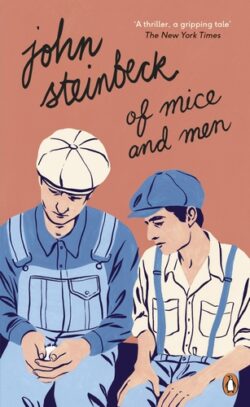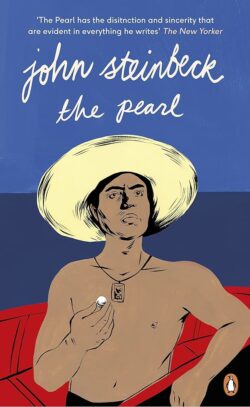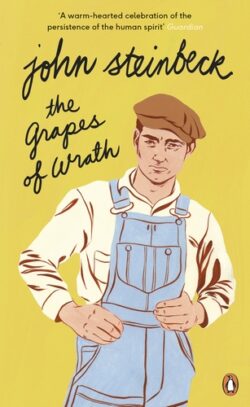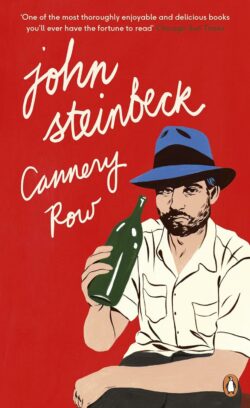in-store offers
Books at Fopp!
John Steinbeck
Fopp proudly features the works of John Steinbeck, one of the great American wordsmiths, with a collection of his novels currently available in our inventory. All available in our 2 books for £7 offer!

John Steinbeck, the illustrious American wordsmith (1902-1968), etched his name in literary history by weaving poignant tales that laid bare the trials of the working class during the tumultuous era of the Great Depression. Hailing from Salinas, California, his early literary endeavors, including Tortilla Flat (1935) and In Dubious Battle (1936), were imbued with the essence of his regional encounters. Steinbeck’s narrative prowess reached its zenith with the release of Of Mice and Men (1937), a pivotal moment that paved the way for his Pulitzer Prize-winning masterpiece, The Grapes of Wrath (1939). This magnum opus served as a searing indictment of societal inequities. Undeterred by political scrutiny, Steinbeck continued to grapple with weighty societal issues in subsequent works like East of Eden (1952) and The Winter of Our Discontent (1961). Despite weathering political criticism, Steinbeck’s indelible mark on American literature was unequivocally recognised with the 1962 Nobel Prize in Literature and his enduring legacy resonates as a profound and resonant voice in 20th-century literature.
 East of Eden
East of Eden
East of Eden unfurls across the sun-drenched expanses of California’s Salinas Valley, a masterwork of American literature, the novel intricately weaves the destinies of the Trask and Hamilton families, creating a literary landscape that resonates with echoes of biblical allegory.
The heart of the book beats with the complex dynamics between the Trask brothers, Charles and Adam, echoing the age-old tale of Cain and Abel. Steinbeck guides us through the emotional crescendos of their relationship—imbued with jealousy, rivalry, and an unyielding pursuit of self-discovery. Enter Cathy Ames, a character of enigmatic moral hues, whose actions cast a pervasive shadow, shaping the destinies of those in her orbit. Against the picturesque backdrop of the Salinas Valley, Steinbeck explores profound themes of free will, morality, and the perpetual interplay between the dualities within the human soul.
Unfolding across decades, mirroring the ebb and flow of life’s complexities. Steinbeck invites readers to a contemplative space, where characters grapple with the choices that define their existence and the ceaseless struggle to harmonize conflicting forces within.
With deft storytelling and rich characterizations, East of Eden prompts introspection into the complexities of good and evil, free will, and the timeless quest for redemption. In the hands of Steinbeck, the Salinas Valley becomes a stage where the human drama plays out, leaving an indelible mark on the landscape of American literature.
 Of Mice and Men
Of Mice and Men
Of Mice and Men orbits around the symbiotic friendship between two drifters, George Milton and Lennie Small. The narrative slices through the American landscape, revealing the harsh realities of the Great Depression.
The story focuses its lens on the microcosm of these two itinerant souls. George, the sharp-witted guardian, and Lennie, his gentle yet mentally challenged companion, embody the resilience of the human spirit amidst adversity. Their dream of owning a piece of land becomes a beacon of hope in a world marked by transience and economic despair.
The supporting cast includes a gallery of characters, each contributing to the harsh realities of the times. The boss, Curley, and his restless wife, encapsulate the struggles of individuals caught in the grip of societal expectations and unfulfilled desires. The ranch itself becomes a metaphor for the transient nature of relationships and dreams in an unforgiving world.
Through spare prose, Steinbeck masterfully unravels themes of shattered dreams, and the pursuit of dignity. The inevitability of tragedy looms over the narrative, creating a sense of foreboding that reverberates through the pages. The novel is a stark reminder that dreams, no matter how vivid, can be crushed under the weight of circumstance.
 The Pearl
The Pearl
The Pearl immerses readers in the coastal village of La Paz, where the quiet life of Kino, a humble pearl diver, takes an unforeseen turn. In this compact yet potent novel, Steinbeck ventures into the realms of desire, greed, and the relentless pursuit of a better life.
Central to the story is the revelation of a pearl, a seemingly divine offering that initiates a sequence of events, forever altering Kino’s course in destiny. As Kino dreams of transforming his family’s life, the pearl becomes a symbol of hope, a shimmering promise in a world burdened by poverty. However, the allure of wealth and the insidious nature of human greed cast a looming shadow over Kino’s aspirations.
The book unfolds within the confined boundaries of a village, yet it resonates with universal themes. The characters, from Kino and his wife Juana to the pearl buyers and the doctor, embody the diverse facets of human nature. Steinbeck employs vivid imagery and symbolic motifs, portraying the pearl as both a blessing and a curse.
The Pearl stands as a concise yet powerful parable, a reflection on the transformative power of material wealth and the profound sacrifices it demands. Steinbeck, with his masterful storytelling, weaves a cautionary tale that echoes through the ages, inviting readers to contemplate the price of pursuing elusive dreams in a world fraught with temptation.
 The Grapes of Wrath
The Grapes of Wrath
Set against the backdrop of the Great Depression, The Grapes of Wrath casts a searing light on the plight of the dispossessed. Set amidst the Dust Bowl’s desolation, the narrative traces the Joad family’s odyssey as they navigate the harsh realities of poverty and the pursuit of the elusive American Dream.
Steinbeck’s canvas is vast, stretching from the arid plains of Oklahoma to the promise of California’s fertile valleys. The Joads, led by Tom Joad, embody the resilience of humans in the face of economic upheaval and societal injustice. As the family confronts systemic oppression, their journey becomes a metaphor for the broader struggle of the working class against exploitative forces.
The novel’s ensemble cast, featuring characters like the preacher Jim Casy and the indomitable Ma Joad, contributes to the rich tapestry of human experience. Each character encapsulates a facet of the collective struggle, reflecting the complex interplay of individual desires and communal resilience.
The symbolism of grapes—the fruit of both sustenance and exploitation—pervades the narrative, underscoring the novel’s exploration of societal inequalities and the dehumanizing effects of unchecked capitalism. Grapes of Wrath transcends its historical context, resonating with themes of social justice and the indomitable human will.
 Cannery Row
Cannery Row
In Cannery Row, Steinbeck paints a vivid portrait of a small, coastal community in Monterey, California, capturing the pulse of life in this eclectic enclave. He delves into the everyday existence of the residents of Cannery Row, crafting a ode to the resilience and camaraderie found in the margins of society.
The reader is introduced to a colourful cast of characters, led by the charismatic and affable Mack. Rather than a grand saga, the novel unfolds episodically, exploring the quirks and intricacies of each character’s existence. The backdrop of the sardine-packing industry provides an industrial hum to the narrative, a reminder of the economic realities shaping the lives of those on Cannery Row.
Compared to other Steinbeck works, the novel takes on a more whimsical and lighthearted tone, showcasing his versatility as a storyteller. Through the lens of Doc, a marine biologist and central figure, the novel explores themes of friendship, community, and the pursuit of happiness amid modest means. The marine specimens in Doc’s lab become symbolic of the beauty that can be found in unexpected places.
The charm of Cannery Row lies in its celebration of the simple joys and communal bonds that emerge from the seemingly mundane. Steinbeck elevates the everyday struggles and triumphs of his characters, infusing the narrative with a poignant, slice-of-life quality. It stands as a testament to the resilience of the human spirit, offering a heartfelt meditation on the value of connection and the richness found in the tapestry of ordinary lives.

 East of Eden
East of Eden Of Mice and Men
Of Mice and Men The Pearl
The Pearl The Grapes of Wrath
The Grapes of Wrath Cannery Row
Cannery Row